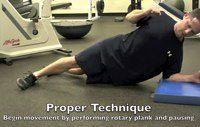The rotary stability plank is one of my go to Functional Stability Training exercises to start training the core to stabilize in multiple planes of motion. The rotary stability plank requires the body to stabilize with anti-extension movement while preventing core rotation. This is a critical component of core stability that I often use as a criteria to achieve before I begin exercises such as chops and lifts. If you haven’t already, go back and read my past post on the rotary stability plank.
One of the key features of the rotary stability plank is training the hips and the trunk to lock in and stabilize the core together. Stuart McGill teaches a much more advanced exercise that works on preventing disassociation of the hips and trunk when transitioning from a front plank to a side plank. Here is a great example of this exercise from Phillip Snell:
Phillip does an outstanding job at stabilizing his core and keeping his hips and trunk locked in together. This is truly a great example. However, this is really difficult to perform, especially for those new to the movement and core training.
I use the rotary stability plank to prepare the body for more advanced exercises like that plank transition. Once you can master the rotary stability plank by itself, there are two more progressions that I will advance towards to help train the hips and core to stabilize together.
The first exercise involves transitioning from a front plank to a side plank against the wall. This is similar to the video above by Phillip, and also recommended by Stuart McGill. By using the wall, you make the exercise much easier than on the ground. More importantly, notice how I incorporate the rotary stability plank into the exercise before I rotate my body:
By performing the rotary stability plank and then transitioning from front plank to side plank, you assure that your body is stabilized. Notice how my forearm comes off the wall first to the stabilize my core and really lock in my hips and trunk?
This exercise can then be progressed to a table top, bench, and then finally the ground. In the example below, I demonstrate a really bad example of how to perform the rotation movement by disassociating my hips and core. This is poor movement quality but unfortunately commonly performed. Again, you can maximize your core stability by performing the rotary stability plank first and then perform the rotational movement.
These progressions are a great example of how to strip down an exercise to maximize movement quality while minimizing compensatory movements. This is one of the fundamental principles that Eric Cressey and I discuss in our Functional Stability Training for the Core program. For more information, please visit FunctionalStability.com.






